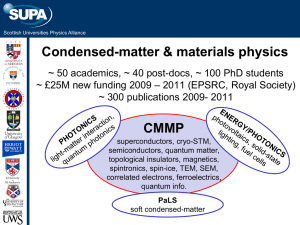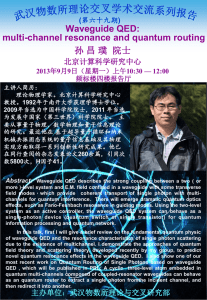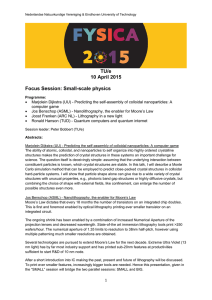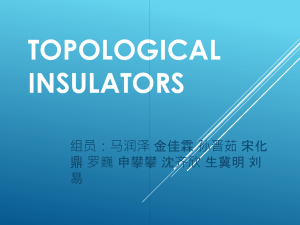2010_obergurgl_v2 - Condensed Matter Theory at Harvard
advertisement
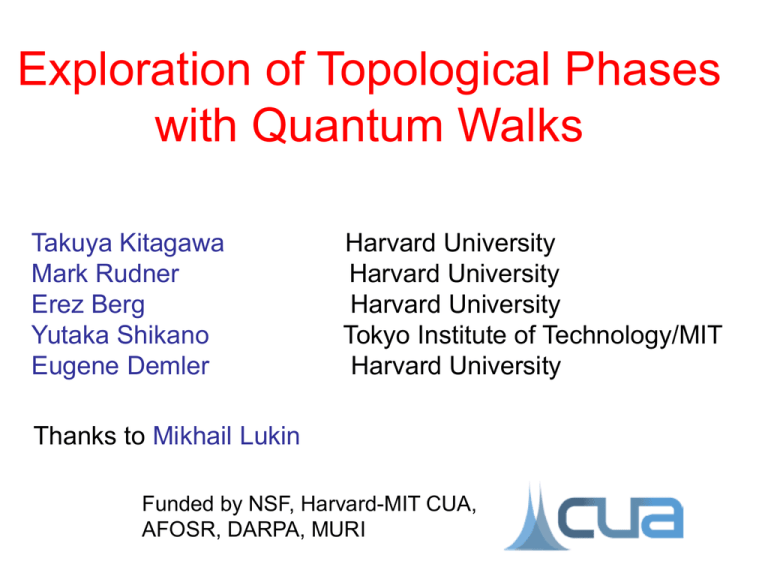
Exploration of Topological Phases with Quantum Walks Takuya Kitagawa Mark Rudner Erez Berg Yutaka Shikano Eugene Demler Harvard University Harvard University Harvard University Tokyo Institute of Technology/MIT Harvard University Thanks to Mikhail Lukin Funded by NSF, Harvard-MIT CUA, AFOSR, DARPA, MURI Topological states of matter Polyethethylene SSH model Integer and Fractional Quantum Hall effects Quantum Spin Hall effect Exotic properties: quantized conductance (Quantum Hall systems, Quantum Spin Hall Sysytems) fractional charges (Fractional Quantum Hall systems, Polyethethylene) Geometrical character of ground states: Example: TKKN quantization of Hall conductivity for IQHE PRL (1982) Summary of the talk: Quantum Walks can be used to realize all Topological Insulators in 1D and 2D Outline 1. Introduction to quantum walk What is (discrete time) quantum walk (DTQW)? Experimental realization of quantum walk 2. 1D Topological phase with quantum walk Hamiltonian formulation of DTQW Topology of DTQW 3. 2D Topological phase with quantum walk Quantum Hall system without Landau levels Quantum spin Hall system Discrete quantum walks Definition of 1D discrete Quantum Walk 1D lattice, particle starts at the origin Spin rotation Spindependent Translation Analogue of classical random walk. Introduced in quantum information: Q Search, Q computations arXiv:0911.1876 arXiv:0910.2197v1 Quantum walk in 1D: Topological phase Discrete quantum walk Spin rotation around y axis Translation One step Evolution operator Effective Hamiltonian of Quantum Walk Interpret evolution operator of one step as resulting from Hamiltonian. Stroboscopic implementation of Heff Spin-orbit coupling in effective Hamiltonian From Quantum Walk to Spin-orbit Hamiltonian in 1d k-dependent “Zeeman” field Winding Number Z on the plane defines the topology! Winding number takes integer values, and can not be changed unless the system goes through gapless phas Symmetries of the effective Hamiltonian Chiral symmetry Particle-Hole symmetry For this DTQW, Time-reversal symmetry For this DTQW, Classification of Topological insulators in 1D and 2D Detection of Topological phases: localized states at domain boundaries Phase boundary of distinct topological phases has bound states! Bulks are Topologically distinct, insulators so the “gap” has to close near the boundary a localized state is expected Split-step DTQW Split-step DTQW Phase Diagram Split-step DTQW with site dependent rotations Apply site-dependent spin rotation for Split-step DTQW with site dependent rotations: Boundary State Quantum Hall like states: 2D topological phase with non-zero Chern number Quantum Hall system Chern Number This is the number that characterizes the topology of the Integer Quantum Hall type states Chern number is quantized to integers 2D triangular lattice, spin 1/2 “One step” consists of three unitary and translation operations in three directions Phase Diagram Chiral edge mode Integer Quantum Hall like states with Quantum Walk 2D Quantum Spin Hall-like system with time-reversal symmetry Introducing time reversal symmetry Introduce another index, A, B Given , time reversal symmetry with is satisfiedby the choice of Take to be the DTQW for 2D triangular lattice If has non-zero Chern number, the total system is in non-trivial phase of QSH phase Quantum Spin Hall states with Quantum Walk In fact... Classification of Topological insulators in 1D and 2D Extension to many-body systems Can one do adiabatic switching of the Hamiltonians implemented stroboscopically? Yes Can one prepare adiabatically topologically nontrivial states starting with trivial states? Yes Topologically trivial Topologically nontrivial Eq(k) Gap has to close k Conclusions • Quantum walk can be used to realize all of the classified topological insulators in 1D and 2D. • Topology of the phase is observable through the localized states at phase boundaries.




